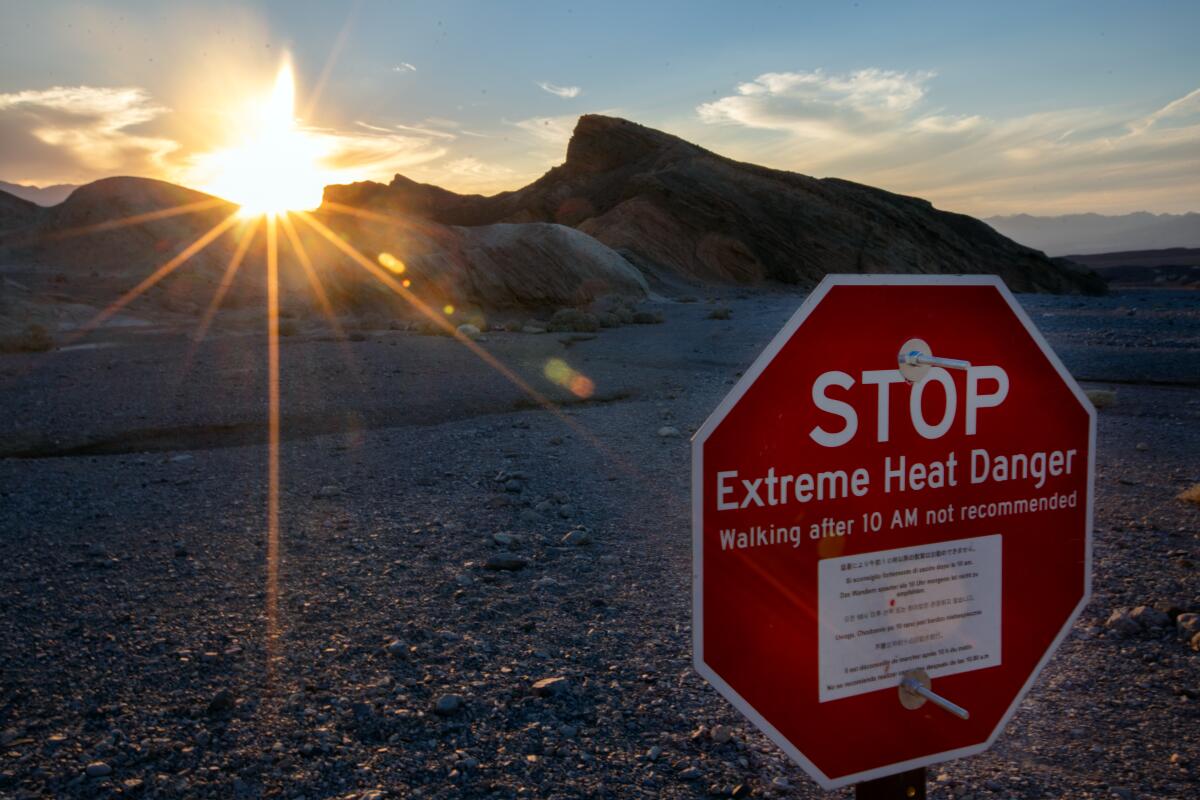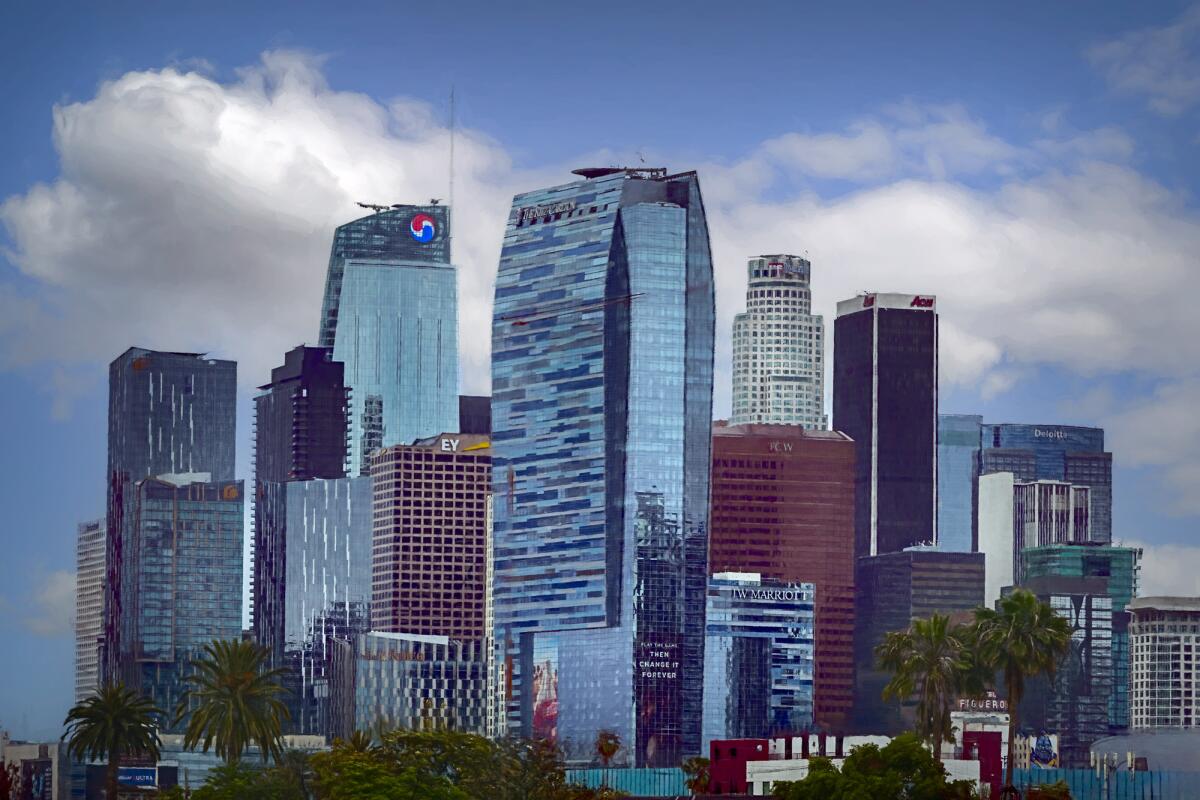It’s only getting hotter and California is struggling to keep up

Good morning, and welcome to the Essential California newsletter. It’s Tuesday, July 18.
The dangerous heat wave that’s been baking much of the state is expected to let up a bit starting today, as the so-called “heat dome” hanging over much of the West moves eastward.
This latest round of extreme heat brought triple-digit temperatures, some new historic heat records and increased fire risk. Some of that risk became reality and crews are continuing to fight wildfires burning across the state.
The largest one in SoCal, the Rabbit fire, had burned an estimated 7,600 acres in Riverside County and was 35% contained as of Monday afternoon.
In Northern California, the Pika fire continues to burn in Yosemite National Park, 18 days after it was sparked by a lightning strike. As of Monday afternoon, that blaze had burned more than 800 acres and was 0% contained.
Inland temperatures soared to more than 100 degrees in some parts of the state. Lancaster Airport in northern L.A. County reached 110 degrees Sunday, breaking a 63-year record for that date. The heat also proved too much for a National Weather Service Doppler radar tower in the Bay Area, which was taken offline “due to the hot weather.”
Then there was Death Valley National Park, where the thermometer hit a truly terrifying 128 degrees, breaking a daily record of 127 degrees reached in 2005 and 1972.
Through this heat wave and many previous ones, government officials and media have shared now-familiar tips and resources to “beat the heat.”
Personally, I’m striving to no longer use that phrase — with its tinge of cutesy fun that feels out of place — when writing about one of the deadliest seasonal weather events. With so many people in California, across the U.S. and around the world facing the dangers of extreme heat and thousands dying each year, maybe it’s time to frame the risks more responsibly.
I’ll spare you too many details on how heat kills, but it can happen through heat exhaustion or the more serious heatstroke — which can severely damage the brain, heart, kidneys and muscles. And some people are more at risk than others.
Extreme heat disproportionately affects children and the elderly, people with chronic illnesses, disabled people and those who are pregnant. It also has a greater impact on people who work predominantly outdoors, such as construction workers, landscapers and agricultural workers.
The California Department of Public Health has been working to assess how vulnerable each county in the state is to extreme heat, based on a variety of environmental and societal factors.
For example, counties with larger populations of non-English speakers are especially vulnerable to the effects of extreme heat, due to what state health officials call “linguistic isolation.” That puts many Californians in L.A., Kern and other counties through the Central Valley at the most risk. Counties with higher poverty rates are also highest on the scale of exposure and sensitivity.
While state officials make those forward projections, the official death toll over the past decade is likely a serious undercount. A 2021 Times examination of state mortality data showed that heat probably caused about 3,900 deaths in the state between 2010 and 2019. The state’s official data accounted for just 599 deaths.
So, as climate change makes extreme heat events more frequent and puts more and more Californians at risk, what is the state doing about it? Historically, not enough.
“Extreme heat did not suddenly become a threat to Californians’ lives,” Times reporters wrote in that 2021 investigation. “The Times found that state leaders have ignored years of warnings from within their own agencies that heat was becoming more dangerous.”
Last year, Gov. Gavin Newsom took a step forward in launching the state’s Extreme Heat Action Plan, which outlines “California’s all-of-government approach to mitigating the health, economic, cultural, ecological, and social impacts of increasing average temperatures and heat waves.”
State officials say they’re focusing on several key objectives:
- Increasing public awareness and outreach about extreme heat and available resources
- Opening cooling centers in affected regions (The state has a resource page linking to available cooling centers county by county, many of them public libraries or park recreation centers)
- Ramping up enforcement on employers to protect workers affected by extreme heat, with a focus on construction, agriculture, landscaping and warehouses
- Improving coordination between state and local agencies to better respond to heat waves
- Investing more in climate resiliency projects, such as by planting more trees, converting asphalt to green space and adding more cool pavement, so our built environment holds up better to extreme heat
And now, here’s what’s happening across California:
Note: Some of the sites we link to may limit the number of stories you can access without subscribing.
L.A. STORIES
L.A. City Atty. Hydee Feldstein Soto has a message for city leaders who want to show solidarity on local picket lines: Please do not. Her office has advised elected officials that voicing support for labor actions could open the city up to future litigation and create conflicts of interest on future council votes. Los Angeles Times
There’s a digital hoard of influencers for pretty much any lifestyle, fandom or hobby imaginable, so it probably won’t come as a shock that fitness-fanatic L.A. is flexing a big gym-fluencer ecosystem. “Between an undeniable emphasis on aesthetics and obsession with wellness,” writes journalist Beatrice Hazlehurst, “Muscle Beach is no longer confined to a strip of sand in Venice, but stretched across the entire city.” Los Angeles Times
POLITICS AND GOVERNMENT
Gov. Newsom is pushing a plan to redirect funding for mental health services, partly to fund more housing for people with severe mental illness. But a new report from the Legislative Analyst’s Office says his plan could take away more than $700 million from existing mental health services. CalMatters
Residents in San Diego’s Barrio Logan neighborhood are appealing the city’s approval of a pipeline project at a controversial biodiesel plant. Residents want the project to undergo an environmental review, which city officials previously deemed was not required. San Diego Union-Tribune
CRIME, COURTS AND POLICING
Twenty-seven years after Lyle and Erik Menendez were convicted of murdering their parents, attorneys and advocates are seeking a fresh look at the case. That comes after new sexual assault allegations against their father, Jose Menendez, which advocates say corroborates a history of abuse the brothers claimed during their initial trial. Los Angeles Times
Anti-Asian hate attacks were down in L.A. County and across the state last year after surging to record highs in 2021. But some take that decrease with a degree of concern, worried the true number of hate crimes could be obscured by fewer Asian American victims coming forward to report attacks and other incidents. Los Angeles Times
Support our journalism
SCIENCE AND THE ENVIRONMENT
A group of students from Palo Alto High School is among 19 teams taking part in the 30th annual Solar Car Challenge, an interstate road trip in solar-powered electric cars they constructed themselves. This year’s eight-day trip began Sunday in Fort Worth as the teams attempt to make it about 1,400 miles to the finish line in Palmdale. KQED
Free online games
Get our free daily crossword puzzle, sudoku, word search and arcade games in our new game center at latimes.com/games.
AND FINALLY
Today’s California landmark comes from Los Angeles resident Frank Damon, who says it “needs no introduction”: The downtown L.A. skyline.

What are California’s essential landmarks? Fill out this form to send us your photos of a special spot in California — natural or human-made. Tell us why it’s interesting and what makes it a symbol of life in the Golden State. Please be sure to include only photos taken directly by you. Your submission could be featured in a future edition of the newsletter.
Please let us know what we can do to make this newsletter more useful to you. Send comments to [email protected].
Sign up for Essential California
The most important California stories and recommendations in your inbox every morning.
You may occasionally receive promotional content from the Los Angeles Times.




